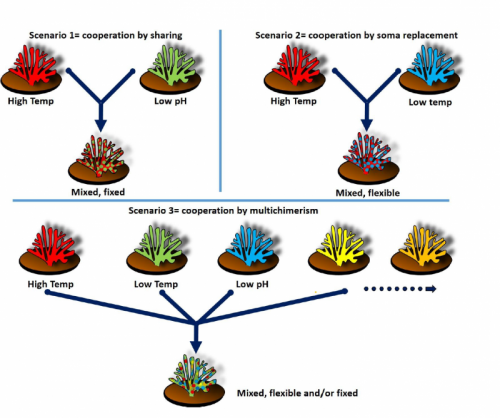The evolutionary survival of coral reefs

Coral reefs
Corals live in symbiosis with an algae : zooxanthellae.
This association is mutually beneficial for both species, and gives them many benefits: nutritive, protection… However, their association is fragile and can easily get disrupted with an increase in temperature of 1 to 2 ° C above the standard oceanic temperature, or other alterations.
The Anthropocene, the geological era that we are currently living in, marked by the impact of men on all ecosystems, is the reason for oceans’ warming and acidification. Corals are becoming rare, and many are dying.
If solutions such as the colonization of new spaces (Yamano et al., 2011, Muir et al., 2015) by individuals, or even phenotypic flexibility are already known and recognized as evolutionary survival mechanisms, they remain limited in the face of rapid deterioration of the corals environment. Corals have a very high genetic variability. This allows some individuals to develop resistance to environmental conditions considered harmful to most corals. Nevertheless for the same reasons mentioned above, the genetic diversity of corals remains limited.
Chimerism
Chimerism, the association of several genomes within an organism, is one of the coral’s specificities and is important to their survival and their genetic diversity. This phenomenon can be observed during the early stages of a coral’s life, mostly in the larval stage. We can therefore hope for an “evolutionary survival mechanism” for corals. For this, and although the exact conditions are still unknown, their chimerism must take place frequently and be stable and adaptable enough to withstand rapid environmental changes across generations.
According to some studies (Raymundo and Maypa, 2004, Amar et al., 2008, Mizrahi et al., 2014), (Rinkevich, 2016), (Boschma, 1929, Barki et al., 2002), chimerism in corals is a key stage in the process of natural selection. Indeed, a chimera possessing several different DNAs from the different cell lines from which it is derived, acts as a genetic repertoire, favoring the complementarity and the synergy of cells. It also has the effect of promoting survival in an inhospitable environment.
Indeed, coral multi-chimerism (more than two different lineages) has been observed to act as a catalyst for population expansion as well as genetic variation, two of the crucial variables to qualify an effective evolutionary survival process. This phenomenon is also known to decrease and slow down poor adaptation to climatic changes taking place in the coral’s natural environment.
In this case, the chimera represents a much more diverse genetic niche, giving it an unprecedented adaptive capacity.
The coral’s chimera has a great flexibility (Fig.1) of gene expression : it is able to adaptatively modify its physiological state, depending on the environment in which it is located.

Figure 1: Chimeras developed from co-stabilized and merged branching spat, Red Sea coral Stylophora pistillata.
(Source : Rinkevich, 2019)
Coral reef adaptation
Chimerism greatly facilitates the coral’s survival when its natural environment is upset. Indeed some genomes, more adapted to certain environmental difficulties will be expressed accordingly. The less suitable genomes will nevertheless be preserved, because a genetic capacity that is not useful at a certain place and at a given time may be needed in another environment.
The genetic niche role of the chimera is not simply to have a great genetic diversity, but also the preservation of genomes that should have disappeared through natural selection (Frank et al., 1997, Barki et al. , 2002, Amar et al., 2008, Amar and Rinkevich, 2010, Jiang et al., 2015).
However, this genetic diversity also modifies the other survival evolutionary processes already played by corals but also by many other species of the marine ecosystem. Indeed, the plurality of coral genomes modifies the equilibrium within the damaged ecosystems, so it can favor a survival system over another or make it totally ineffective.
Our understanding of corals’ systems is therefore questioned. The pressure of human activities has dramatically accelerated environmental changes. As a result, many species have not had time to adapt to these rapid changes. Corals and all ecosystems that depend on them could therefore evolve in a way never imagined until now.
In the near future, coral chimerism could serve as a biomimetic model for the active restoration of degraded coral reefs. Many studies must nevertheless be done to really understand the mechanisms involved in coral chimerism.

